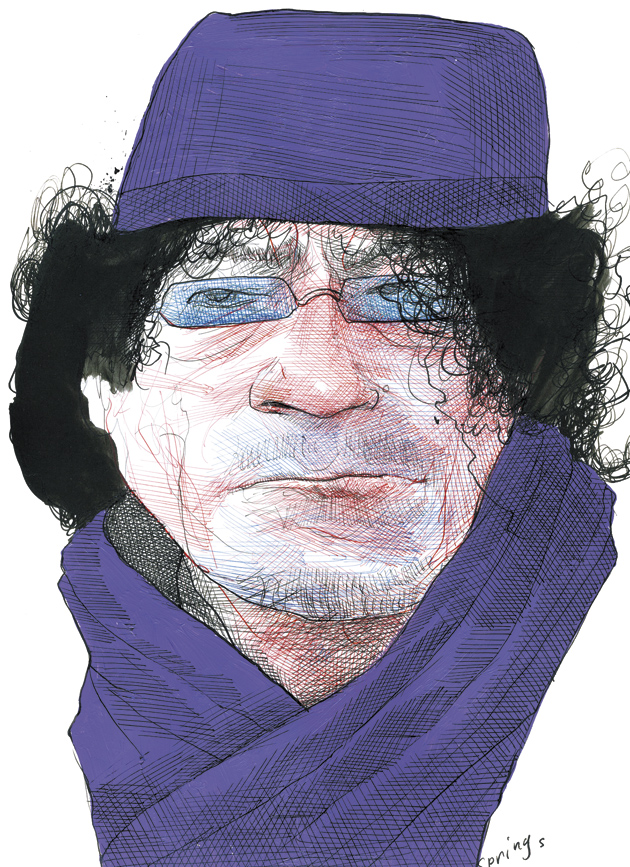If any further proof is needed of Libyan strongman Muammar Qaddafi’s mental instability it is provided by WikiLeaks dispatches from US diplomats in Tripoli in November and December of 2009. At issue was some nearly loose nuclear material, a Russian plane, and a lone security guard—a footnote in the WikiLeaks scandal that many may have missed. But first, a little background.
Almost from the moment he assumed power in 1969, Qaddafi was interested in acquiring nuclear weapons. He tried to buy them from China; and when that failed he tried to build them himself. In the 1990s he bought an entire turnkey nuclear weapons program from the Pakistani proliferator A.Q. Khan, including centrifuges and designs for a nuclear weapon. It is believed he gave up the entire program in 2003 in a grand bargain with the United States that eventually restored Libya’s diplomatic status and allowed US companies to do business with the oil-rich country.
But there remained and still remains a nuclear research program centered in Tajura, about ten miles east of Tripoli. The centerpiece of the program is a relatively small research reactor built in 1979 by the Russians, who also supplied the fuel. After it came on line, it apparently employed hundreds of technicians, including some who had studied in the United States. I have looked at the list of research publications that have been released by scientists connected with the Tajoura facility and the papers seem quite standard to me.
However there is a special feature of this reactor that needs comment: it is fueled by highly enriched uranium—apparently an 80 percent enrichment of uranium 235. This level of enrichment or greater was fairly common for small research reactors and dates back to the Atoms For Peace program inaugurated by President Eisenhower. The uranium was military surplus. Some of it is unaccounted for and is a proliferation threat. At 80 percent enrichment it would be adequate for use in at least a crude nuclear device. In the Libyan case, the amount of enriched uranium used in the reactor is less than what would be necessary for a weapon. But having this much possible bomb fuel in a country like Libya is not desirable. The Russians seem to have understood this and established a program to remove the spent fuel from Tajoura and fly it back to Russia—or at least that was what was supposed to happen.
In September of 2009 Qaddafi came to New York for the annual meeting of world leaders at the UN. He wanted to pitch a large tent in Central Park, which he was going to occupy, and he wanted to visit Ground Zero. He was denied both and his anger smoldered until November when he figured he had a way to take his revenge. According to nuclear agreements between Libya, Russia, and the US, seven five-ton casks of spent uranium from Libya’s research reactor were scheduled to be shipped to Russia for safekeeping, and the Russians sent a special plane to Tripoli to retrieve them.
But Qaddafi refused to let the casks leave, and they remained in Tajoura under the watch of a single armed guard. This became known to the American embassy, and the US Ambassador in Tripoli, Gene A. Cretz, began cabling Washington with increasing desperation. “Following a four-day standoff,” one cable recounted on November 25,
the Russian plane scheduled to remove Libya’s last remaining HEU spent fuel stores departed Libya without its cargo. Despite bilateral agreements with the US and Russia—and intensive outreach efforts by the US and Russian Ambassadors—Libyan officials unexpectedly refused to allow the HEU to leave the country. DOE experts are deeply concerned by the safety and security risks posed by the Libyans’ decision.
Officials in the United States believed there was very little time to deal with the situation. As the cable continued:
According to the DOE experts, we have one month to resolve the situation before the safety and security concerns become a crisis.… If the enriched uranium is not removed from the casks in three months, its rising temperature could cause the casks to crack and release radioactive nuclear material.
The fact that the people who would be irradiated would be Libyans did not seem to faze Qaddafi, who, as we now know, also thinks nothing of strafing his own citizens with aircraft fire.
In any case, the Americans—who had meanwhile been giving Qaddafi high marks for his “political genius” and staying power—decided to keep the matter of the casks secret. Another communiqué from a US diplomat read: “Given the highly transportable nature of the HEU and the shoddy security at Tajoura, any mention of this in the press could cause serious security concerns.” It added: “The Libyan government has chosen a very dangerous issue on which to express its apparent pique about perceived problems in the bilateral relationship”—a delicate phrasing. The matter was resolved when Secretary Clinton sent Qaddafi a personal message assuring him of the United States’ regard for him and his country. The Russian plane left Tripoli on December 21, 2009, with the uranium. For the moment, the Tajoura reactor remains in the part of the country still controlled by forces loyal to Qaddafi, who has vowed to “fight to the last drop of blood” to remain in power. Its current status is unknown.
Advertisement



